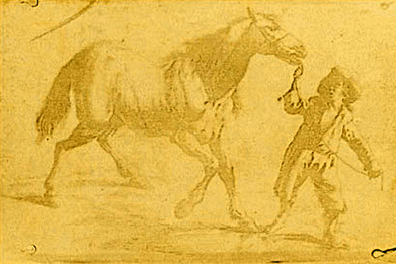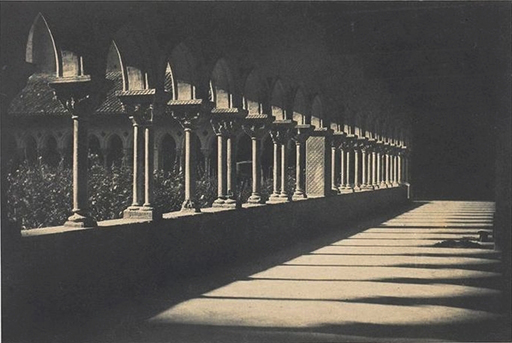History Of Photography – Niépce, Daguerre, and Talbot
Part One Of An Ongoing Series
In the interval between, roughly, 1830 and 1840, the earliest processes that we can reasonably consider to be photography were invented, by at least three men: Niépce, Daguerre, and Talbot.
Nicéphore Niépce invented a very very slow emulsion based on bitumen of Judea (a naturally occurring light sensitive glop which hardens, very very slowly, upon exposure to light) and a way of fixing the image eventually formed (wash away the glop that has not hardened.) This is one of his earliest efforts, which actually reproduces an engraving, rather than a scene from life.

Louis Daguerre developed the daguerreotype, a faster emulsion on a somewhat less cumbersome substrate. Reproductions of daguerreotypes, such as the one below, are a bit subversive being much easier to “see” than the originals which are a little finicky about viewing angle and tend to be quite small.

Henry Fox Talbot invented first salt printing (a “printing out” paper negative which is simply exposed, and then fixed) and then the calotype (a “latent image” paper negative which is exposed, developed, and then fixed).
The dates do not much matter, and you can look them up. The point is that, as of about 1835, this was an idea whose time had come. Artists had been using camera obscura devices for some time. These devices cast an image of whatever was in front of the lens on to some surface, from which it could be copied or traced. Artists had long been muttering that it certainly would be nice to be able to preserve, to fix, the cast image on to some permanent medium, saving the tedious and inaccurate business of hand-copying it.
In about 1830, sufficient knowledge of chemistry and sufficient availability of bulk chemicals became available in western Europe, and more or less inevitably, this dream became reality, multiple times over.
At that moment in time, the goal was simply to fix an image. There was, initially, no particular greater point, no ambition toward Art, no specific design to produce technical records, nothing beyond simply making a permanent image on a piece of paper, canvas, metal. Anything flat. Not surprisingly, the methods first devised for making those permanent images were profoundly limited, and those limitations dictated what kinds of pictures got made by which methods in those early years.
The first few pictures from this interval are very much of a type, they are based largely on what was possible, not on what the photographer might have wanted to record a picture of. There are a lot of what are instantly recognizable as “test images.” Mostly, the earliest images are random outdoor scenes and hastily assembled still lifes. In fairly short order, more or less as soon as the technology was able to produce exposures of tolerable (barely) length, we see a few other types turn up.
There are some shenanigans involving patents and intellectual property which initially make Talbot’s processes less attractive to use, and Niépce’s process while historically important was never practical for photography, with its exposures measured in hours. This left Daguerre with an out-of-the-gate lead.
As a result, daguerreotypes briefly dominated the scene. They had some problems. A daguerreotype is a unique object, it cannot be reproduced (not easily, at any rate), it is fragile, and it is, ultimately, a thin sheet of metal. It is a little hard to look at as some viewing angles work and others do not. On the other hand, it is cheap and very very sharp. This made it suitable for portraits, at least portraits conceived as keepsakes: small, fragile, precious. The daguerreotype is largely useless for hanging on the wall, and while it is useful as a reference for, say, making a woodcut, it is not suitable for directly making copies for, say, books.
Therefore, inevitably, the daguerreotype became the preferred medium for the portrait and had a secondary life as a source of artist references for various uses (everything from figure studies to a guide to engravings of various sorts).
Talbot’s process, the calotype, was a bit soft, relying as it does on a paper negative. While Impressionism had not quite arisen, there were precursors a-plenty in painting. J.M.W Turner has some influence at this point, Jean-François Millet is rising, and so on. Whether or not any given photographer was influenced by any given painter may not always be clear, but in the air we have the idea that perhaps clarity of detail, sharpness, is not always a necessity. Perhaps, photographers began to think, the softness of the calotype could be worked with rather than struggled against. And so, they did that.
The calotype was, as noted, somewhat encumbered by patents as Talbot tries to monetize his invention. But, it could be reproduced, being the first form of what we now recognize as a standard positive/negative process, and it did make objects suitable both for hanging on the wall and gluing in to books. These were desirable properties. After some tinkering, the French successfully bypassed the Talbot’s patents, at least well enough, and began making lots of paper negatives and from those, paper prints. At the very tail end of this era, just as the glass plate methods are being devised, the French Government commissioned the Mission Héliographique, to document the nation’s architecture. This produced a modest collection of rather beautiful architectural studies.

The calotype made headway, therefore, according to its own properties.
This is to say that within a couple of years we begin to see a bifurcation in usage between technologies: daguerreotypes are used one way, calotypes another. This is not surprising, of course, one uses what is suitable to the task. What makes this interesting is that tasks for which things might or might not be suitable turn up fairly quickly. Photography as a discipline in its own right is beginning to take shape.
In not too much more time it will occur to someone (Archer) that glass plates might combine the best of both worlds.
This is a continuing series by author – Andrew Molitor
Andrew Molitor
July 2019
Bellingham, WA
Andrew is an ex-mathematician, ex-software engineer, full-time-dad. Sometimes he takes pictures, and sometimes he writes about pictures, and he's always got opinions.

